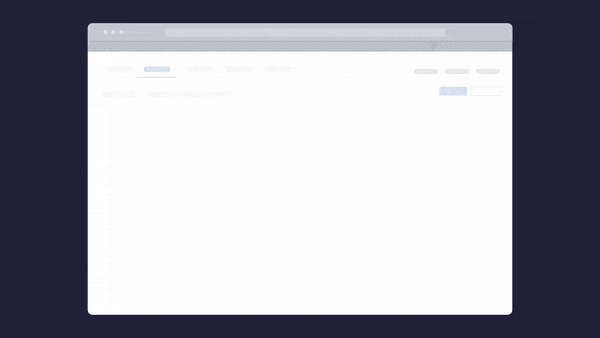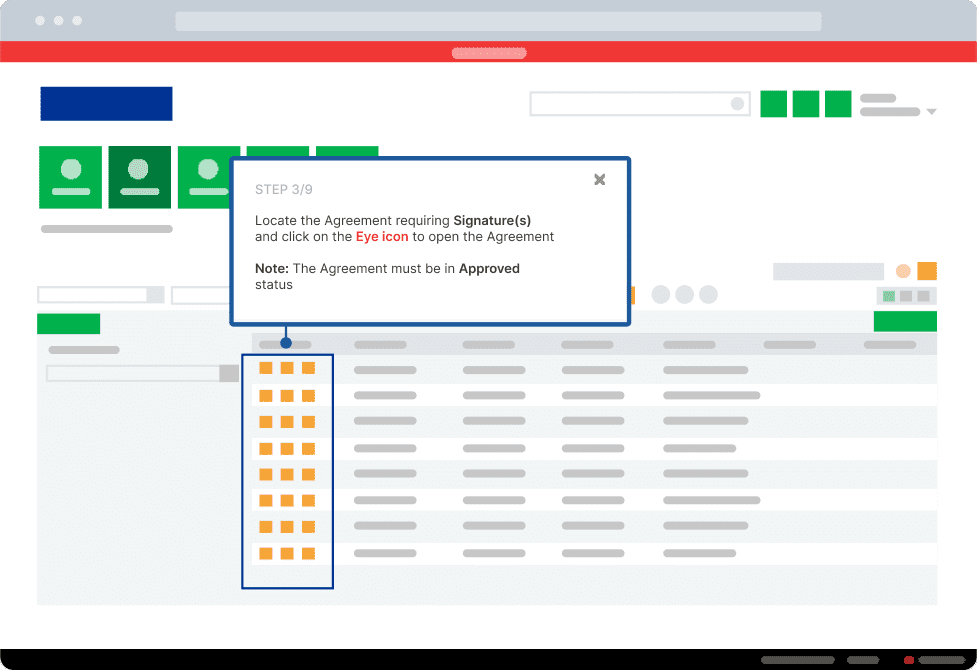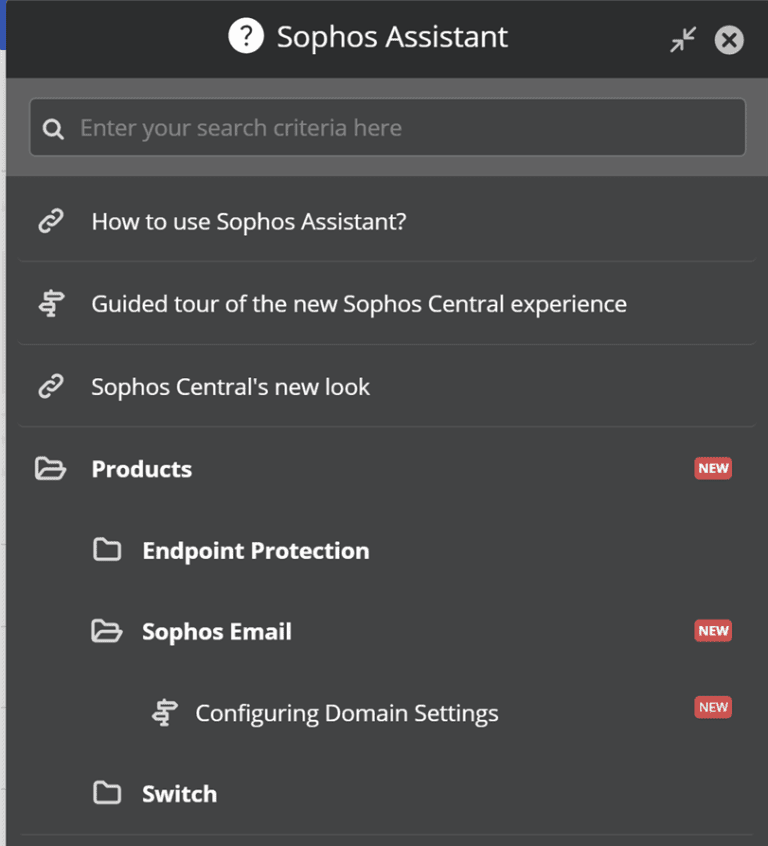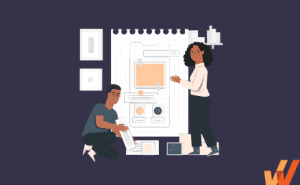In-app guidance refers to interactive, product-led user onboarding experiences like product tours, guided walkthroughs, and new user checklists.
Whether you want to drive customer end-user adoption or enable your internal employee end-users with contextual performance support to drive user adoption of enterprise software, you can achieve it with in-app guidance.
In-app guidance introduces new end-users to software capabilities and the contextual workflows for their use cases directly in the app without in-person training.
In this article, we’ll explore the concept of in-app app guidance, share common types of interactive guidance, break down examples, and introduce you to the best tools for creating in-app guided experiences.
What Is In-App Guidance?
In-app guidance enables end-users with interactive, contextual assistance and support through a combination of in-app elements. It may include interactive walkthroughs, tooltips, checklists, self-help wikis, and other UX elements that help to educate users on product functionality, drive engagement, provide contextual assistance, and achieve product adoption.
8 Types of In-App Guidance Formats
In-app guidance can take multiple forms – let’s distinguish eight standard UX element formats for in-app guidance.
1. Product tours
A product tour is a sequence of tips displayed to new users once they log into the application for the first time. These in-app support tutorials introduce users to product features step-by-step. A product tour uses a combination of UX elements, from pop-ups, task lists, and interactive walkthroughs that are often contextual guidance to different personas, depending on the use case of the end-user.

2. Smart tips
The problem with product tours is that users typically skip them. This is where smart tips come in handy. These are on-demand tooltips that can be called by hovering the cursor over a specific element on a page. They can also provide field validations or reminders for process changes.
![]()
3. Onboarding task lists
To encourage users to go through the entire onboarding process and master a new feature or app, product teams create user onboarding checklists as part of their onboarding UX. Onboarding task lists offer steps a user must go through to navigate the app’s features.

4. Flows and interactive walkthroughs
Interactive walkthroughs help users master a feature or product workflow by prompting in-app, step-by-step guidance to help users interact with a product’s interface. These in-app user guides encourage them to take action once they’ve learned something new. For instance, after reading a tooltip on how to add new contacts to the CRM system, the user can practice it right away for better understanding.

5. Alerts and beacons
In-app guidance should not only tell users what to do but also warn them when something goes wrong. Alerts and UX hotspots help notify people when they don’t use the feature as intended, when application errors arise, or to help them with new feature discovery.
![]()
6. Self-help resource centers
Resource centers enable end-users with on-demand user assistance, FAQs, and support material in a searchable wiki that overlays a product’s UI. This wiki can automatically crawl and aggregate a company’s FAQs, knowledge base, training materials, and other support resources into a single self-help, 24/7 resource center.

Above: Whatfix Self Help integrates with your knowledge base, FAQs, technical documentation, process documentation, training resources, video tutorials, and more – providing a searchable resource center that overlays your UI and enables end-users with contextual, moment-of-need support.
7. Field validation
Field validation provides end-users with contextual tips and error messages on the correct format for entering data into form fields and what fields are mandatory. This improves the end-user experience with contextually relevant information, improves sign-up experiences for customer-facing products, and enables organizations to keep their data clean by providing in-app reminders to employee end-users in the flow of work.

Above: Whatfix Field Validation provides in-line, real-time alerts and form-field error messages for end-users on why text input isn’t being accepted, improving form completion rates and keeping data clean.
8. Pop-ups
Pop-up messages are modal windows that act as a UI overlay and provide a method of in-app customer and end-user communication for product teams. Pop-ups are an excellent way to drive awareness of new feature launches, promote new webinars and resources, alert end-users of product improvements, remind end-users of upcoming deadlines or events, communicate company or team news, and more.

Above: Whatfix Pop-Ups are an excellent way for product teams to announce new features or for IT/HR teams to remind employees of an upcoming deadline for things like performance reviews or benefits enrollment. With Whatfix Pop-Ups, embed a video, create a carousel of different announcements, prompt an in-app experience, or link to an external resource like your changelogs or help article.
Related Resources:
Benefits of In-App Guidance
There are many reasons for you to spend time developing in-app guidance. Let’s have a look at the most significant ones.
1. Contextual onboarding and reduced time-to-value
Have you heard of the “aha!” moment? It happens when a product user first realizes its value for their use case. The aha moment triggers a positive emotional reaction among users and helps them understand how a product has solved a problem, answered a question, or taught them a new skill.
In-app guidance helps drive users to this moment faster, reducing time-to-value for realizing a product’s full capabilities. This is accelerated even more when user onboarding experiences are contextual to the use case of different types of users.

2. Increase user engagement
In-app guidance creates a whole new channel for driving user engagement by offering many ways for you to interact with users indirectly—through to-do lists and interactive walkthroughs.
Instead of relying on release notes, customer success meetings, or training sessions to introduce a new feature and train end-users on how to take advantage of it, SaaS products and IT teams can create interactive guidance inside an application that walks end-users step-by-step through a new capability or workflow – all available on-demand, directly inside app.

3. Enable learning by doing
Product demos are effective at briefly introducing new end-users to a platform’s capabilities. Yet, there’s a strong chance end-users will forget what they’ve learned once they are inside the application, post-tour. The only way to master a platform is by putting it into practice, ie. learning by doing.
In-app guidance enables learning in the flow of work by providing end-users with contextual assistance and support, as well as the guidance tools to find real-time answers to their questions at the moment of need.

4. Boost user proficiency and self-serviceability
In-app guidance enables end-users to perform tasks and resolve issues without asking IT or support teams for help.
This self-help model enables end-users to learn on their own, increasing user proficiency in the software or application that results in more proactive, efficient employees and happier, more self-empowered customers.

5. Drive user adoption
In-app guidance leads to successful user adoption, which happens when a user fully acclimates to the product and knows exactly how to resolve their problems. And when users understand the product’s value, they are more eager to include it in their daily routines.
6. Reduce support tickets
In-app guidance takes the burden off your support reps and IT team. When being able to call a self-help widget or tooltip, users will reach out to support agents less frequently – helping to significantly reduce customer support tickets.
Create In-App Guided Experiences With Whatfix
With the Whatfix DAP, enable your end-users with in-app guidance and contextual user support. With Whatfix’s no-code editor, create branded in-app content such as product tours, user onboarding checklists, tooltips, beacons, pop-ups, self-help wikis, and more. Create more effective customer and employee onboarding experiences, provide interactive process documentation, alert employees and customers to process updates or new feature launches, guide users through infrequent tasks, and provide self-help support. Gather customer and employee feedback with native surveys and understand user behavior with Whatfix’s no-code event tracking and analytics.
When Should You Use In-App Guidance?
There are two main use cases for in-app guidance: driving product adoption for customers and users and supporting internal employees when introducing new business software.
1. In-App Guidance for Customers
These are the most common cases when your customers need in-app guidance:
- Customer and user onboarding. You should create product tours, interactive walkthroughs, and task lists for new users during customer onboarding to navigate the features that will help them address their problems. Personalizing onboarding flows for new customers based on their specific pain points is a smart way to drive business outcomes and adoption,and guide new customers through your applications with a user onboarding checklist.
- New product update and feature release. Use in-app notifications and guidance to alert users when you launch new features, walk users through the workflow of these new features, and inform customers of product or workflow updates.
- Self-help support. Whenever users face minor issues, they should be able to resolve them on their own. To enable them to do so, create step-by-step troubleshooting guides your customers can call through a self-help widget. Customer self-service not only deflects tickets but is the end-user support strategy that users prefer.
- Continuous product adoption and end-user training. User adoption doesn’t end when the onboarding process finishes. Users will need in-app guidance throughout their entire customer journey with your product to continue adopting it successfully.
2. In-App Guidance for Employees
Encouraging software adoption among employees has become critical for businesses only recently. Creating in-app guidance for internal teams allows companies to reduce SaaS waste and increase employee productivity.
Here’s when providing employees with in-app training is most important:
- Training employees on new software. When you introduce new business software to your team, hosting a one-off workshop isn’t enough. Work together with a software provider or implement a digital adoption platform (more on this below) to create onboarding flows for every tool in your tech stack.
- Self-help support. Even after going through a detailed onboarding flow, people will have questions as they’re getting to know the product. Implement a self-help widget your employees can turn to when tooltips aren’t sufficient.
- Operational change. As you develop internal operations and develop more effective ways to perform tasks, don’t forget to communicate it in in-app guidance. This may be from a new workflow, performing an infrequent task, or migrating to a new software vendor.
- New feature launch. Typically, service providers inform customers of new feature releases. But if it doesn’t happen or you use custom-built software, you must notify employees about product changes through in-app alerts.
New to DAP? Explore these resources to learn more about digital adoption platforms.
Examples of In-App Guidance
The best B2B SaaS products and B2C apps offer in-app guided experiences, including interactive walkthroughs, tooltips, self-help widgets, beacons, and task lists. The leading enterprises across industries use digital adoption platforms to enable their application end-users with in-app guidance.
We’ve compiled some of our favorite in-app guided experiences from IT teams enabling their employee end-users on internal software applications and SaaS platforms empowering their customer end-users.
1. PlayOJO’s new gamer onboarding and in-app engagement campaigns
With Whatfix, PlayOJO created in-app experiences that provided contextual user onboarding, retained users with player engagement pop-ups, and reduced player drop-offs by fixing areas of user friction.
PlayOJO standardized its in-app messaging and experiences with Whatfix to facilitate seamless gaming adoption and learning through personalized content, step-by-step guidance, and in-app communication. These guided pathways streamline and accelerate the onboarding of new customers, simplify the gaming experience, and increase customer satisfaction.

Intelligent and intuitive Whatfix features like guided pop-ups, beacons, and contextual self-help are transforming the platform experience. In the last six months alone, more than 500,000 unique users viewed Whatfix content. Some 21 pop-ups were shown more than 300,000 times and 26 flows were played more than 170,000 times – including over 62,000 ‘Hot or Cold explained’ flows. Almost 25,000 support queries were served.
For example, PlayOJO offers customers ‘Kickers’ – daily promotions personalized around individuals’ gaming routines. Rozario and his team created a series of popups linked to these Kickers, offering customers the option to participate in a recent ‘Everyone’s a Winner’ campaign.

2. Sophos provides contextual end-user support to customers with Self Help
Sophos’ Firewall platform is its flagship product offering, and the company faced challenges on guiding customers end-users through the complexities of firewall configuration, deployment, and maintenance. Accurate configuration was vital, as adversaries only needed to be lucky once to bypass a customer’s firewall and gain access to sensitive data, networks, and devices.
With Whatfix, Sophos enabled its customers with interactive in-app guidance and contextual self-support to thousands of Sophos Firewall end-users, which was launched as “Sophos Assistant” and provided a self-help overlay on its web admin console UI.

Sophos Assistant aggregated and curated Sophos help desk articles, training resources, product documentation, and how-to support into a searchable self-help wiki. These entries are then connected to third-party links, pop-ups videos, or prompt guided in-app flows, like the one below, which walk end-users step-by-step through tasks and workflows.

The results were instant and highly-effective – deflecting Firewall customer support tickets by 12,000 annually and saving 1,070 hours on employee training and support-related time.
3. Ferring Pharmaceuticals enables its Icertis end-users with in-app guidance
Ferring Pharmaceuticals accelerated its CLM transformation and standardized its CLM processes and tasks with Whatfix to re-imagine how hundreds of employees use the CLM platform. With Whatfix, Ferring used in-app guidance to enable its Icertis end-users, reduce new user onboarding time, increase overall Icertis adoption, and delivered a more engaging contract management experience.

Ferring accomplished this by identifying recurring user challenges and adding contextual information (Smart Tips) in the CLM at the point of these challenges. With Smart Tips, users no longer had to wait for help desk assistance when they had a question – the answer was immediately available, increasing agility and creating a self-reliant culture. Nearly 4,000 Smart Tips created with Whatfix are now shown to users every day.
4. Looms new feature tour
Loom recently integrated AI capabilities into its screen recording product, which can auto-transcribe screen recordings and videos into documents, create JIRA tickets based on recordings, and write Slack or email copy that allows you to share videos with detailed background on what it covers – all with a simple click.
To drive awareness and adoption of Loom AI, a new feature overlay tour was created that guides users through the new capabilities. It first prompts users with a UI overlay that provides a quick overview of the feature, as well as highlights the three areas of the web app where you can find these AI-powered features. Clicking “next” starts users on the feature tour.

Next, it auto-creates a long-form document based on the video you just recorded. Loom provides a quick on-screen overlay that provides context on the feature, letting users know how to use it. The right side of the screen is Loom AI in action, providing a contextual example of the feature. It’s not only an example, it’s the actual feature in action – which users can copy and paste into a document to realize the full value of this feature.

From there, Loom then walks users through its AI-powered auto-JIRA ticket creation by again showing users Loom AI in action, using the recently recorded video. It also prompts Loom AI to create a message to share the video with fellow colleagues.

5. Hotjar’s onboarding checklist
Hotjar greets new users with an on-demand onboarding checklist that helps users get to know the product features.
What’s particularly good about this example? It doesn’t disrupt the user experience. To call the widget, you need to press the button at the bottom of the page. Unless you do it, Hotjar will not disturb your workflow with an intrusive pop-up window or a product tour you didn’t ask for.

6. ClickUp’s interactive walkthroughs
The ClickUp team doesn’t use product tours. They prefer interactive walkthroughs that enable their customers to learn by doing. To unlock new recommendations, users need to take certain actions.
Like Hotjar’s onboarding checklist, ClickUp’s walkthrough isn’t intrusive. You can simply ignore it — and it won’t interrupt any workflow.

7. Serpstat’s smart tips
Every search engine optimization (SEO) platform has its own algorithms for calculating metrics. Therefore, it’s critical for Serpstat, an SEO tool, to provide contextual tooltips to explain the terms and concepts that appear within its product interface.
Tooltips are usually brief and only touch upon the topics, without going too deep in detail.

8. Slack’s self-help widget and Slackbot
Alongside offering product walkthroughs for newbies, Slack empowers users with self-help content. Topics can be accessed through a button in the right corner of the screen. Once you press it, a help tab appears and lets you search topics that might answer your question.
Why is this example remarkable enough to make it to this list? A self-help widget opens right within the Slack app — it doesn’t redirect you to a new page. Users can read through help topics without moving to a different page, which makes it easy to follow the guidance and doesn’t disrupt the user experience.

5 Tools to Create In-App User Guidance
You don’t have to be a tech professional to create in-app guidance. You just need the right digital adoption platform (DAP) that will provide you with an interface to layer contextual help to your software.
1. Whatfix
Whatfix is a no-code digital adoption platform and product analytics suite that’s used to create in-app experiences to drive adoption for customer-facing teams, product managers, and IT support teams.
It’s a no-code DAP that integrates with your product(s) and enables non-technical team members to create in-app guidance and self-help support that overlays on your applications. Not only does Whatfix offer contextual assistance within any application, but it also monitors user behavior to provide you with actionable real-time insights on how people use a product or business software.
Whatfix also provides teams with a no-code analytics solution to analyze product engagement, usage, and adoption.
With Whatfix’s digital adoption platform, non-technical team members are empowered to create, launch, and analyze in-app guidance such as:
- Product tours
- Interactive walkthroughs and step-by-step user guides
- User onboarding task lists
- Alerts, hotspots, pop-ups, and tooltips
- Field validations
- Feedback surveys and quizzes
- Sandbox environments for risk-free interactive user training and testing
2. Salesforce In-App Guidance
If you’re looking to create in-app guided content specifically to drive Salesforce adoption, it providers a native solution to create in-app walkthroughs and add prompts to drive platform adoption. Businesses can write customized help content, select the target audience, and schedule different flows. It also provides customizable reports with real-time user engagement insights.
To access it, install the In-App Guidance package. The package is generally available to all Salesforce users.

3. Pendo
Pendo is a digital adoption platform where you can create self-service resources, collect user feedback, and monitor product engagement — all in one interface.
The platform allows you to collect audience insights and use them to personalize help content for each user. It also offers solutions for guiding users through mobile experiences.

4. Appcues
Appcues is software for designing personalized product experiences. Similar to other platforms on the list, it enables you to build product walkthroughs, measure user engagement, and collect feedback with in-app surveys.
After installing the SDK, you can create flows with no-code Appcues Builder. It’s easy to personalize user journeys by choosing who and when sees the content you’ve created. You can target users dynamically based on behavior or attribute like demographics.

5. Userlane
Userlane offers a no-code solution for producing and maintaining training and support content. With it, you can create product tours, announce updates, promote marketing content, start surveys, and offer self-service support. Userlane’s solutions are helpful when you need to introduce new software to your team or familiarize your customers with new product features.

Software Clicks Better With Whatfix
Whatfix empowers users to unlock their true potential across all software experiences – web, desktop, and mobile. Guide users through complex applications and processes with in-app Flows, Task Lists, Smart Tips, Pop-Ups, and more to enable end-users to learn in the flow of work with product-led experiences. Enable end-users with Self Help, an in-app resource center that integrates with your existing knowledge repositories and support resources, providing contextual answers to user queries at the moment of need. Gather engagement and usage data on your in-app content built with Whatfix. See Task List completion rates, Flow dropoffs, Smart Tip views, common Self Help queries, and more.








